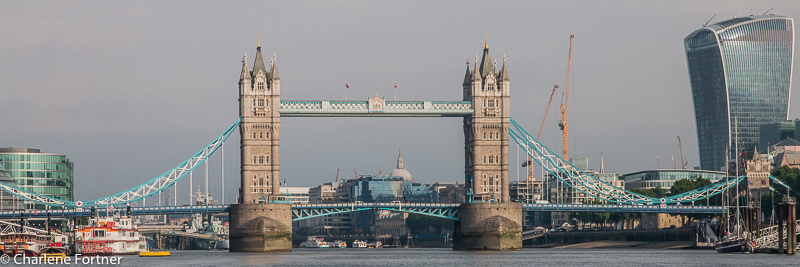Blog posts on my summer trip to England are long overdue! While I’m sure most of my readers are more interested in the pictures and itineraries, I feel that it is also important to explain how I planned for a 5-week solo trip overseas.
Logistics of a Long Trip
I spent the better part of 8 months planning, booking and building an itinerary for a 35-day trip to England. The majority of this time was spent on overall logistics and building itineraries.
My Planning Style

Rain, Rain…go away!
@ Vindolanda
The paving stones meant to allow you to cross the stream to the temple are completely flooded thanks to non-stop rain for most of my trip at Hadrian’s Wall.
I cannot bring myself to go on a vacation without a plan; whether it is for a day or a week. For me, this does not mean planning every minute of every day. Simply put, the task of creating and using a daily itinerary gives me a piece of mind. It allows me to enjoy myself more than if I were to wing it and feel like I missed something. My itineraries usually allow for flexibility and include research for back-ups when weather and transportation snafus require detours. In my previous travels, I have dealt with these occasions resourcefully and with a care-free attitude. English weather made sure that my planning was tested this time around as well.
Setting up a Structure
The prospect of moving my luggage to a new lodging every day or two was unappealing. For this reason, I decided to create “bases” from which I could explore an area for 3-5 days. The most daunting part of planning a trip of this magnitude was to identify where to visit and how long to stay.
Choosing my Bases
Weeding out my impossibly large bucket list was a grueling task.

Screen Shot of Google Maps for Base: London
Amazingly I did more than half of the items marked on this map! (In 9 days, of course.)
I used Google Maps to add possible attractions I was interested in. Useful sites for research included the National Trust, English Heritage, and the Historic Houses Association. After adding the possibilities to the map, then began the weeding process. My first criteria for culling was simple: which places could I visit by public transit without walking more than 1 mile. If I had to walk more than that, was the location somewhere I could spend all day (ex. Blenheim Palace)? I also compared and eliminated similar sites. For example, how many museums on Roman history did I really need to go to? This managed to narrow down my sites into reasonable geographical pockets to make bases.
My final itinerary focused on 7 regional or city bases. Off the bat, several bases were non-optional: Hadrian’s Wall, London, and York. Of the remaining areas I used several criteria to narrow down my bases:
- Transportation options to get to and from the chosen base.
- Available transportation options to the attractions near that base.
- Available budget accommodation.
- Enough attractions or things to do to fill several days.
Despite missing a few items on my must-see list, the additional bases I settled on were Oxford, the Lake District, Bath, and the Norfolk Coast. I ended up spending only one night each in both Carlisle and Cambridge due to breaks in transportation between bases. I also split my time in London to spend time at the beginning and end of my trip there.
Travel Between Bases
The next big decision to make was what order to move from base to base, what time of the day to travel and what mode of transportation to take.
A circular route would be more favorable, both due to cost and to reduce travel time between bases. However, some of the bases I chose were centered around specific events which complicated the order. I was also constrained by the availability of lodging due to some festivals. Not to mention, the Lake District can book up months in advance, something I did not plan for (surprisingly).
An important consideration was what time of the day to travel. My preference is to travel in the early morning or late evening to maximize sightseeing hours during times that many attractions are open: 1000-1700.
While train travel is faster, it is also more costly. I compared the cost, timetables of available routes and length of travel time using the research tools of Rail Journey Planner (train), Megabus and National Express (both coach bus). I created a plan utilizing both rail and bus routes between bases. Some transfers were a combination of both because rail travel can’t get you everywhere! With the exception of one transfer that involved an overnight bus, none of the base transfer legs took more than three hours, and most were less than two.
Lodging Reservations
Lodging was by far the most complicated and stressful part of the planning process due to my budget. The majority of lodgings available to me would be hostels, bunkhouses or cheaper B&Bs. The majority of my bookings were made through the YHA Hostels.
I did utilize TripAdvisor to check reviews, however, I always take these with a grain of salt and try to read a lot of current reviews to get a feel for the places. Many people have a varying degree of tolerance for certain features of a place and I don’t tend to be picky at all. I certainly don’t care if the cafe is awful at a place if I don’t plan to eat there. I purchased a membership with Hostelling International which entitled me to a discount when I checked in to the YHA hostels.
Not everything goes according to plan…
Unfortunately, this process did not go without a hitch. When I began to make my reservations, about five months prior to leaving, I came to realize that some of my chosen accommodations were already booked or were booking up fast! This caused a cascade of revisions to several parts of my trip:
- Apparently, lodging along Hadrian’s Wall is scarce and gets booked up fast! Even the back-ups I had identified were booked! I had to resort to booking two nights at a mid-range B&B rather than the bunkhouses I originally planned on. On the plus side, I got my own room and bathroom for two nights. Oh, and the hot breakfast was nice too! (More about this place later!)
- Budget lodging in the Lake District also books up early! I emailed a few places in hopes that I could find an opening even though they showed no vacancy online. No luck. Unfortunately, I had to cut my time short in the Lake District, spend a night in Carlisle and add a day to my base in York. I think I would like to revisit this area when I return to visit Scotland or Wales.
- Many hostels are closed on weekdays during term times (when schools are in session) or off-peak times. For my June and early July bases, some of the hostels had limited dates and/or availability. This complicated my stay in Cambridge and in York. In Cambridge, I had to shorten my stay to one night and push two nights to the Norfolk leg of my trip. (Not a loss!) This also required me to seek more expensive lodging in York for three of the five nights at that base. But again, this meant I got my own room for a few nights, so it was not a loss either.
Luggage Storage
This was the first extended trip I planned without access to a car. My goal was to keep the total weight of my bags under 30 lbs/14 kg. (I did this!) For a few days along Hadrian’s Wall I would have to carry all of my items for several miles. This goal also allowed me to bring back souvenirs and stay under the airline baggage weight limit.
Part of my planning process required researching options for luggage storage. Left luggage facilities are becoming extinct. Heightened security has seen many of these services become discontinued. Most rail stations do not offer self-service lockers anymore (do any of them?). I had to choose hostels or B&Bs that provided some form of luggage storage before and after check-out. In the case of the hostels, this required renting a locker or paying a fee. It was helpful to search the reviews on TripAdvisor for more information and read the experiences of other travelers on this matter.
On most days I stored my backpack at my accommodation and carried my day bag around town. When selecting a day bag, I chose one that could easily fit inside of the larger backpack on the days that required me to carry all of my things. This also meant leaving enough space in my backpack to accommodate all of my things!
Along Hadrian’s Wall I utilized a baggage transfer service that moved my luggage between accommodations so I was able to carry less while hiking long distances. These services are common along the long-distance trails in the UK.


